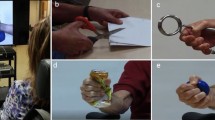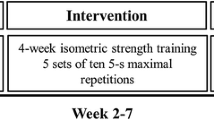Abstract
Evidence suggests that the cross-transfer of strength following unilateral training may be modulated by increased corticospinal excitability of the ipsilateral primary motor cortex, due to cross-activation. Anodal-tDCS (a-tDCS) has been shown to acutely increase corticospinal excitability and motor performance, which may enhance this process. Therefore, we sought to examine changes in neural activation and strength of the untrained limb following the application of a-tDCS during a single unilateral strength training session. Ten participants underwent three conditions in a randomized, double-blinded crossover design: (1) strength training + a-tDCS, (2) strength training + sham-tDCS and (3) a-tDCS alone. a-tDCS was applied for 20 min at 2 mA over the right motor cortex. Unilateral strength training of the right wrist involved 4 × 6 wrist extensions at 70 % of maximum. Outcome measures included maximal voluntary strength, corticospinal excitability, short-interval intracortical inhibition, and cross-activation. We observed a significant increase in strength of the untrained wrist (5.27 %), a decrease in short-interval intracortical inhibition (−13.49 %), and an increase in cross-activation (15.71 %) when strength training was performed with a-tDCS, but not following strength training with sham-tDCS, or tDCS alone. Corticospinal excitability of the untrained wrist increased significantly following both strength training with a-tDCS (17.29 %), and a-tDCS alone (15.15 %), but not following strength training with sham-tDCS. These findings suggest that a single session of a-tDCS combined with unilateral strength training of the right limb increases maximal strength and cross-activation to the contralateral untrained limb.



Similar content being viewed by others
References
Ackerley SJ, Stinear C, Byblow WD (2011) Promoting use-dependent plasticity with externally-paced training. Clin Neurophys 122:2462–2468
Arányi Z, Rösler K (2002) Effort-induced mirror movements. Exp Brain Res 145:76–82
Carroll TJ, Herbert RD, Munn J, Lee M, Gandevia SC (2006) Contralateral effects of unilateral strength training: evidence and possible mechanisms. J Appl Physiol 101:1514–1522
Carroll TJ, Lee M, Hsu M, Sayde J (2008) Unilateral practice of a ballistic movement causes bilateral increases in performance and corticospinal excitability. J Appl Physiol 104:1656–1664
Carson RG (2005) Neural pathways mediating bilateral interactions between the upper limbs. Brain Res Rev 49:641–662
Carson RG, Riek S, Mackey DC, Meichenbaum DP, Willms K, Forner M, Byblow WD (2004) Excitability changes in human forearm corticospinal projections and spinal reflex pathways during rhythmic voluntary movement of the opposite limb. J Physiol 560:929–940
Cernacek J (1961) Contralateral motor irradiation—cerebral dominance. Its changes in hemiparesis. Arch Neurol 4:165–172
Cogiamanian F, Marceglia S, Ardolino G, Barbieri S, Priori A (2007) Improved isometric force endurance after transcranial direct current stimulation over the human motor cortical areas. Eur J Neurosci 26:242–249
Edwards DJ, Krebs HI, Rykman A, Zipse J, Thickbroom GW, Mastaglia FL, Pascual-Leone A, Volpe BT (2009) Raised corticomotor excitability of M1 forearm area following anodal tDCS is sustained during robotic wrist therapy in chronic stroke. Restor Neurol Neurosci 27:199–207
Fregni F, Boggio PS, Santos MC, Lima M, Vieira AL, Rigonatti SP, Silva MTA, Barbosa ER, Nitsche MA, Pascual-Leone A (2006) Noninvasive cortical stimulation with transcranial direct current stimulation in Parkinson’s disease. Mov Disord 21:1693–1702
Goodwill AM, Pearce AJ, Kidgell DJ (2012) Corticomotor plasticity following unilateral strength training. Muscle Nerve 46:384–393
Hendy AM, Kidgell DJ (2013) Anodal tDCS applied during strength training enhances motor cortical plasticity. Med Sci Sports Exerc 45:1721–1729
Hinder M, Schmidt M, Garry M, Carroll TJ, Summers J (2011) Absence of cross-limb transfer of performance gains following ballistic motor practice in older adults. J Appl Physiol 110:166–175
Hinder M, Schmidt M, Garry M, Summers J (2013) The effect of ballistic thumb contractions on the excitability of the ipsilateral motor cortex. Exp Brain Res 227:19–29
Hopf HC, Schlegel HJ, Lowitzsch K (1974) Irradiation of voluntary activity to the contralateral side in movements of normal subjects and patients with central motor disturbances. Eur Neurol 12:142–147
Hortobágyi T, Taylor JL, Petersen NT, Russell G, Gandevia SC (2003) Changes in segmental and motor cortical output with contralateral muscle contractions and altered sensory inputs in humans. J Neurophysiol 90:2451–2459
Hortobágyi T, Richardson SP, Lomarev M, Shamim E, Meunier S, Russman H, Dang N, Hallett M (2011) Interhemispheric plasticity in humans. Med Sci Sports Exerc 43:1188–1199
Howatson G, Taylor MB, Rider P, Motawar BR, McNally MP, Solnik S, DeVita P, Hortobágyi T (2011) Ipsilateral motor cortical responses to TMS during lengthening and shortening of the contralateral wrist flexors. Eur J Neurosci 33:978–990
Hummel F (2006) Effects of brain polarization on reaction times and pinch force in chronic stroke. BMC Neurosci 7:73
Hummel F, Celnik P, Giraux P, Floel A, Wu WH, Gerloff C, Cohen LG (2005) Effects of non-invasive cortical stimulation on skilled motor function in chronic stroke. Brain 128:490–499
Keel JC, Smith MJ, Wassermann EM (2001) A safety screening questionnaire for transcranial magnetic stimulation. Clin Neurophysiol 112:720
Kidgell D, Pearce A (2010) Neural adaptations following cross-education strength training: a pilot study. J Sci Med Sport 12:500–502
Kobayashi M, Pascual-Leone A (2003) Transcranial magnetic stimulation in neurology. Lancet Neurol 2:145–156
Koeneke S, Lutz K, Herwig U, Ziemann U, Jäncke L (2006) Extensive training of elementary finger tapping movements changes the pattern of motor cortex excitability. Exp Brain Res 174:199–209
Kujirai T, Caramia MD, Rothwell JC, Day BL, Thompson PD, Ferbert A, Wroe S, Asselman P, Marsden CD (1993) Corticocortical inhibition in human motor cortex. J Physiol 471:501–519
Lee M, Gandevia SC, Carroll TJ (2009) Unilateral strength training increases voluntary activation of the opposite untrained limb. Clin Neurophysiol 120:802–808
Lee M, Hinder MR, Gandevia SC, Carroll TJ (2010) The ipsilateral motor cortex contributes to cross-limb transfer of performance gains after ballistic motor practice. J Physiol 588:201–212
Liebetanz D, Nitsche MA, Tergau F, Paulus W (2002) Pharmacological approach to the mechanisms of transcranial DC stimulation induced after effects of human motor cortex excitability. Brain 125:2238
Mayston MJ, Harrison LM, Stephens JA (1999) A neurophysiological study of mirror movements in adults and children. Ann Neurol 45:583–594
Meyer BU, Roricht S, von Einsiedel HG, Kruggel F, Weindl A (1995) Inhibitory and excitatory interhemispheric transfers between motor cortical areas in normal humans and patients with abnormalities of the corpus callosum. Brain 118:429–440
Munn J, Herbert RD, Gandevia SC (2004) Contralateral effects of unilateral resistance training: a meta-analysis. J Appl Physiol 96:1861–1866
Nitsche MA, Paulus W (2000) Excitability changes induced in the human motor cortex by weak transcranial direct current stimulation. J Physiol 527:633–639
Nitsche MA, Paulus W (2001) Sustained excitability elevations induced by transcranial DC motor cortex stimulation in humans. Neurology 57:1899–1901
Nitsche M, Fricke K, Henschke U, Schlitterlau A, Liebetanz D, Lang N, Henning S, Tergau F, Paulus W (2003) Pharmacological modulation of cortical excitability shifts induced by transcranial direct current stimulation in humans. J Physiol 553:293–301
Nitsche MA, Seeber A, Frommann K, Klein CC, Rochford C, Nitsche MS, Fricke K, Liebetanz D, Lang N, Antal A, Paulus W, Tergau F (2005) Modulating parameters of excitability during and after transcranial direct current stimulation of the human motor cortex. J Physiol 568:291–303
Nitsche MA, Cohen LG, Wassermann EM, Priori A, Lang N, Antal A, Paulus W, Hummel F, Boggio PS, Fregni F, Pascual-Leone A (2008) Transcranial direct current stimulation: state of the art 2008. Brain Stimul 1:206–223
Perez MA, Cohen LG (2008) Mechanisms underlying functional changes in the primary motor cortex ipsilateral to an active hand. J Neurosci 28:5631–5640
Purpura DP, McMurtry JG (1965) Intracellular activities and evoked potential changes during polarization of motor cortex. J Neurophysiol 28:166
Rantalainen T, Weier A, Leung M, Brandner C, Spittle M, Kidgell D (2013) Short-interval intracortical inhibition is not affected by varying visual feedback in an isometric task in biceps brachii muscle. Front Hum Neurosci 7:68
Ridding MC, Taylor JL, Rothwell JC (1995) The effect of voluntary contraction on cortico-cortical inhibition in human motor cortex. J Physiol 487:541–548
Ruddy KL, Carson RG (2013) Neural pathways mediating cross education of motor function. Front Hum Neurosci 7:397
Scripture EW, Smith TL, Brown EM (1894) On the education of muscular control and power. Stud Yale Psychol Lab 2:114–119
Tanaka S, Hanakawa T, Honda M, Watanabe K (2009) Enhancement of pinch force in the lower leg by anodal transcranial direct current stimulation. Exp Brain Res 196:459–465
Tanaka S, Takeda K, Otaka Y, Kita K, Osu R, Honda M, Sadato N, Hanakawa T, Watanabe K (2011) Single session of transcranial direct current stimulation transiently increases knee extensor force in patients with hemiparetic stroke. Neurorehabil Neural Repair 25:565–569
Van Duinen H, Renken R, Maurits NM, Zijdewind I (2008) Relation between muscle and brain activity during isometric contractions of the first dorsal interosseus muscle. Hum Brain Mapp 29:281–299
Weier AT, Pearce AJ, Kidgell DJ (2012) Strength training reduces intracortical inhibition. Acta Physiol 206:109–119
Ziemann U, Ishii K, Borgheresi A, Yaseen Z, Battaglia F, Hallett M, Cincotta M, Wassermann EM (1999) Dissociation of the pathways mediating ipsilateral and contralateral motor-evoked potentials in human hand and arm muscles. J Physiol 518:895–906
Zijdewind I, Butler JE, Gandevia SC, Taylor JL (2006) The origin of activity in the biceps brachii muscle during voluntary contractions of the contralateral elbow flexor muscles. Exp Brain Res 175:526–535
Zoghi M, Nordstrom M (2007) Progressive suppression of intracortical inhibition during graded isometric contraction of a hand muscle is not influenced by hand preference. Exp Brain Res 177:266–274
Acknowledgments
D.J. Kidgell is supported by an Alfred Deakin Postdoctoral Fellowship.
Conflict of interest
The authors declare that they have no conflict of interest.
Author information
Authors and Affiliations
Corresponding author
Rights and permissions
About this article
Cite this article
Hendy, A.M., Kidgell, D.J. Anodal-tDCS applied during unilateral strength training increases strength and corticospinal excitability in the untrained homologous muscle. Exp Brain Res 232, 3243–3252 (2014). https://doi.org/10.1007/s00221-014-4016-8
Received:
Accepted:
Published:
Issue Date:
DOI: https://doi.org/10.1007/s00221-014-4016-8




